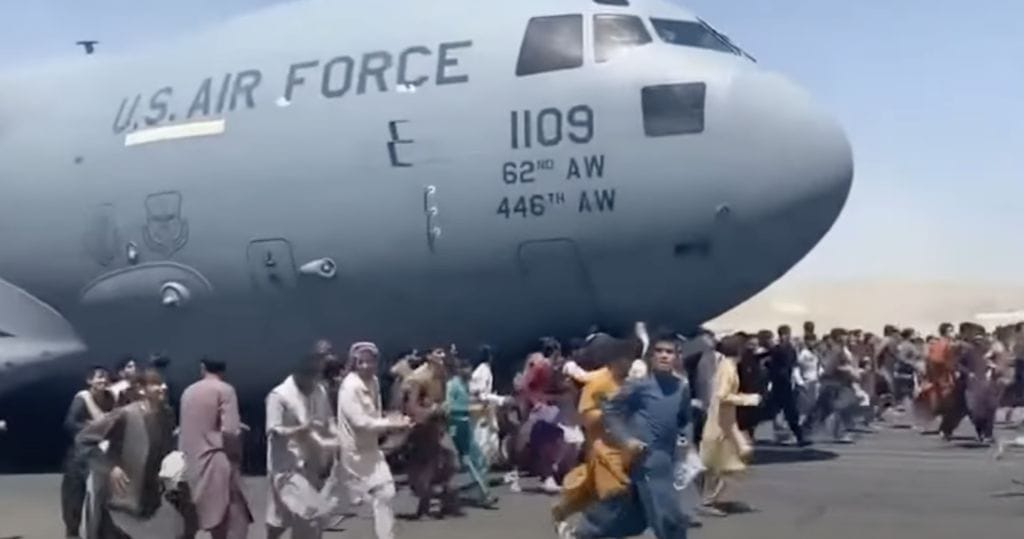The Special Inspector General for Afghanistan Recontruction (SIGAR), John Sopko, has released his latest evaluation regarding the U.S. withdrawal of troops from Afghanistan.
The report presents findings as to precisely why the Afghan government collapsed in August 2021 amid the botched US withdrawal. After the US left, the Islamic extremist Taliban that America had been fighting for years retook control and reintroduced oppressive and draconian measures, dialing back two decades of what had been viewed as progress.
The US has continued to pour a great deal of taxpayer funds into Afghanistan after the withdrawal. According to the Inspector General, the US is the largest foreign funder of Afghanistan, contributing $1.1 billion to help the Afghan people in the year since the Taliban took over.
Unfortunately, the Inspector General reports that due to obstruction by federal agencies, he has been unable to report or account for all of that taxpayer money, even though that’s his primary assigned function. He says it’s the first time the agencies, including the State Department, have refused cooperation at such a high level, rendering him unable to perform his oversight.
The new report is in response to a September 10, 2021 request from Congressional Republicans.
The Inspector General’s office says it conducted over 80 interviews with more than 60 current and former US officials, former Afghan government officials, and experts on Afghanistan’s history and social structures.
Below are some key points from the report:
Key Points:
SIGAR identified six factors that contributed to the collapse of the Afghan government:
– The Afghan government failed to recognize that the United States would actually leave;
– The exclusion of the Afghan government from U.S.-Taliban talks weakened and undermined it;
– Despite its weakened position, the Afghan government insisted that the Taliban be effectively integrated into the Republic, making progress on peace negotiations difficult;
– The Taliban were unwilling to compromise;
– Former Afghan President Ashraf Ghani governed through a highly selective, narrow circle of loyalists, destabilizing the government at a critical juncture;
– The Afghan government’s high level of centralization, endemic corruption, and struggle to attain legitimacy were long-term contributors to its eventual collapse.
SIGAR identified four findings surrounding the question of whether U.S. governance objectives were achieved:
– The United States sought to build stable, democratic, representative, gender-sensitive, and accountable Afghan governance institutions. It failed.
– The United States failed to resolve the issue of corruption; to legitimize the Afghan government through democratic elections; and to adequately monitor and evaluate the outcomes and impacts of its efforts.
– Some progress was made. In both the public and private sectors, the combination of available opportunities and the training and education provided by the United States and its international partners led to increased human capital and institutional capacity. Capacity building was imperfect, but did yield some results.
– Residual elements of the Afghan government still exist and are functioning, although their sustainability is uncertain.
— Chris Mason, associate professor of national security at the U.S. Army War College, asserted, “U.S. efforts to build and sustain Afghanistan’s governing institutions were a total, epic, predestined failure on par with the same efforts and outcome in the Vietnam war, and for the same reasons.”
— The fact that the United States had supported Afghanistan for 20 years and that Afghanistan had been highly dependent on external support for much of its modern history, made it all the harder for Afghan politicians and leaders to envision a future without such support. Their inability to imagine that scenario prevented the Afghan government from preparing for a U.S. withdrawal, former Acting Special Representative for Afghanistan and Pakistan (SRAP) Laurel Miller suggested. Miller described this phenomenon as “the unfathomability of ‘what do we do when the Americans leave?’”
— Because of tensions within the U.S. government surrounding the issue of whether full withdrawal was the right policy, Afghan officials heard what they considered to be contradictory messages about whether a U.S. withdrawal would actually happen. That made it possible for Afghan officials to listen only to those “who were giving them more optimistic scenarios,” Miller said.
— Before the collapse of the Afghan government in August 2021, the primary U.S. goal in Afghanistan was to achieve a sustainable political settlement that would bring lasting peace and stability. The Taliban’s refusal to talk to the Afghan government without first negotiating with the United States was an obstacle to that goal. A similar occurrence happened in 2018, when the United States began direct talks with the Taliban. The U.S. direct negotiations with the Taliban excluded the Afghan government, weakening the negotiating position of the Ghani government and strengthening the Taliban. As Hugo Llorens, former U.S. special chargé d’affaires for Afghanistan, summarized, “Just talking to the Taliban alone and excluding our allies proved the Taliban’s point: The Afghan government were our puppets, you didn’t need to talk to them. You only need to talk to the Americans.”
— The U.S.-Taliban agreement appeared to have emboldened the Taliban. Lisa Curtis, a senior director for South and Central Asia on the National Security Council from 2017 to 2021, told
SIGAR, “It was a U.S. withdrawal process.… all the Taliban really did was agree not to attack U.S. forces on their way out.” As a result, the agreement likely led Taliban leaders to seek a resolution to its conflict with the Afghan government on the battlefield rather than through peace talks.
— Exclusion from U.S.-Taliban talks and the subsequent signing of the February 2020 agreement was a blow to the credibility of the Afghan government. Despite these developments, the Afghan government insisted during intra-Afghan negotiations that the Taliban be integrated into the Republic. As Fatima Gailani, a member of the Republic’s negotiating team told SIGAR, after 6 months of negotiations, it was clear to her that not everyone, but most people close to former Afghan President Ashraf Ghani, were delusional because they were unwilling to compromise. As was the Taliban.
— Gailani told SIGAR that President Ghani was waiting for another U.S. government to come and undo President Trump’s withdrawal policy. Referring to months of stalled talks with the Taliban, she stated, “Three months we wasted because they [Ghani and his inner circle] were 100 percent sure that Mr. Biden will come and will say what Mr. Trump did was a disaster. ‘Goodbye, no talks, no agreement—the Doha Agreement—let’s start from the beginning.’ And the big Republic family will start all over again.”
— Ghani’s obliviousness to the troubling realities confronting his country was a problem even in the early days of his administration. Former Ambassador Michael McKinley told SIGAR that the Afghan president consistently suggested development goals that were “completely off the charts,” and that his apparent “separation from Afghan reality” was concerning. Ghani was “living in fantasyland,” McKinley said.
— Ghani was isolated from voices and opinions beyond his handpicked inner circle of confidants. Eventually, this circumstance contributed to the unraveling of Afghanistan’s loosely knit government. Consequently, Ghani made decisions without a diversity of contrasting perspectives or contextual information, which undermined the effectiveness of the government institutions that he led. At the same time, the gulf between the president’s inner circle and reality outside the palace walls meant that Afghanistan’s most senior powerbrokers were unable to effectively respond to security developments.
— From the outset of the U.S. reconstruction effort until its ultimate collapse in August 2021, the Republic struggled to attain legitimacy. The Afghan government’s high degree of centralization, combined with its fragile and corrupt nature, compounded its legitimacy problem and ultimately contributed to its demise.
— The United States believed that economic and social development programming would increase support for the Afghan government and reduce support for the Taliban insurgency. However, the theory that economic and social development programing could produce such outcomes had weak empirical foundations. Former Ambassador McKinley noted, “It wasn’t that everyone, including conservative rural populations, didn’t appreciate services …. But that didn’t seem to change their views.” As Mason of the U.S. Army War College told us, “This idea … that if you build a road or a hospital or a school, people will then come on board and support the government—there’s no evidence of that occurring anywhere since 1945, in any internal conflict. It doesn’t work.” As Scott Guggenheim, former senior advisor to President Ghani, told SIGAR, “Building latrines does not make you love Ashraf Ghani.”
— The rapid disintegration of Afghan security forces and the Ghani administration in August 2021 represented the dramatic conclusion of a two-decade, U.S.-led effort to develop and westernize Afghan society. That ambitious endeavor included not only strengthening the capacity of the Afghan government directly, but also improving Afghanistan’s economy, constructing infrastructure, supporting Afghan media, bolstering the health and education sectors, and even altering gender relations. Although the ultimate failure of those efforts is undeniable, it is also clear that the time and money the international community committed to Afghanistan over the course of a generation achieved some semblance of change.
— The Islamic Republic of Afghanistan no longer exists but many of its government institutions still function under the Taliban. Running on “inertia” due to some amount of carryover from the prior government, the ministries of finance, health, economy, and education, among others, and the country’s central bank, have continued to execute some basic functions. The Taliban are also using systems and processes developed under the previous government to conduct some government functions.
Read full report here: https://www.sigar.mil/pdf/evaluations/SIGAR-23-05-IP.pdf

The Lemonade Mermaid Store
Unique gifts for Land or Sea Mermaids, Mer-pets and Little Mermaids!
Left: Our signature Fish Scales design tote bag in Citrus




I spent a year living in Kandahar working for KBR keeping their food cold. During this period I met many Afghans and repaired HVAC equipment in the “secret” Cia,nsa,fbi etc. compound. The military and intelligence agencies whispered promises that were not kept due to incoming politicians changing priorities and couldn’t care less about what happened. As a result thousands were killed and maimed. Smart and connected ones got out like Iraq. Our three letter agencies are directly responsible and have been meddling there for nearly 70+ years as they currently are. The real story is in the history of Peshawar, Pakistan, a former spy capital of the world.
We have sent billions (that’s 9 zeros) of dollars to Afghanistan. And they are not the only country we send tax payer money to. Where is all that money? I would wager some of it has ended up in our political leaders’ bank accounts. I would also wager it has ended up in many corrupt beaucrats bank accounts as well. When will the American people wake up and demand accountability from our political leaders? Our government really needs to fix all the problems in our country and stop interferring around the world.
Post Vietnam the US military did a complete overhaul and rebuild to shake off the fiasco of the loss. Congress appropriated less money 1975 to 1981
Post Afghanistan it feels like the US military is using the loss as a template.